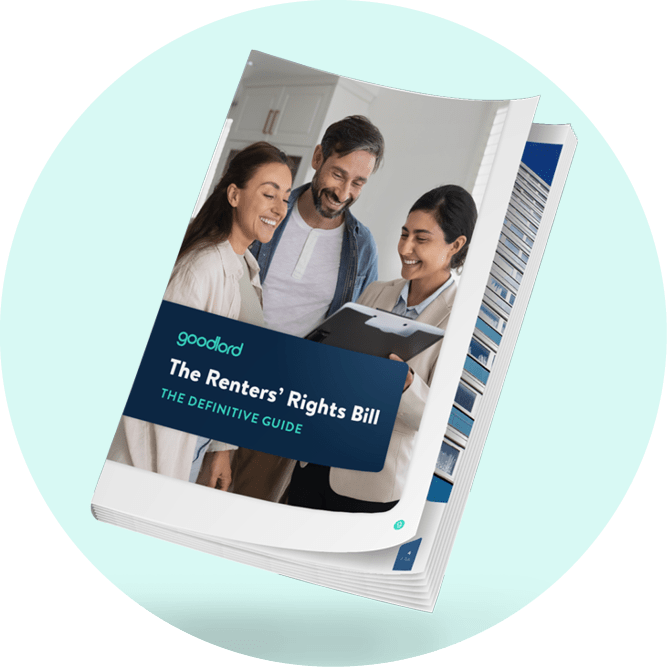Understanding housing discrimination: A guide for landlords and agents
The Renters’ Rights Act expands protections for tenants. Learn what it means for housing discrimination laws and landlord responsibilities.
Despite the efforts of ethical self-regulating landlords and agents, the spectre of discrimination still haunts parts of the Private Rented Sector (PRS).
Data from the housing charity Shelter says that 110,000 families have missed out on a home they wanted in the last 6 years because they had children.
While housing discrimination is already illegal in the UK under the Equality Act 2010, the Renters’ Rights Act aims to close gaps in that legislation. It will make it illegal to discriminate against families with children and tenants on benefits.
Landlords and agents found to have unlawfully discriminated against a tenant can face civil proceedings and be ordered to pay compensation under the Vento bands, which currently range from £1,200 to £60,700 depending on the severity of the harm caused (more on that later).
This makes embedding fairness and consistency throughout your entire lettings journey and documenting your tenant selection processes essential.
In this blog, we'll explore the software that can help you achieve this, while also helping you to understand and avoid discriminatory practices.
- Understanding housing discrimination in the UK
- Social housing vs. private rentals
- The Renters' Rights Act and housing discrimination
- Impacts on landlords and letting agents
- Legal consequences for non-compliance
- Practical steps to avoid discrimination
- How Goodlord helps landlords and agents stay compliant
- Conclusion
Understanding housing discrimination in the UK
The Equality Act 2010 is a vital piece of legislation that makes it unlawful for a person letting out or managing a property to discriminate against individuals or groups with a protected characteristic.
Under the current law, these characteristics are:
- Disability (including mental health and physical disabilities)
- Race
- Religion or belief
- Sex
- Sexual orientation
- Gender reassignment
- Pregnancy and maternity
- Age
- Marriage and civil partnerships
The Renters’ Rights Act will build upon the list to include tenants with children and those on benefits or housing allowances. It’s also worth noting that some protected characteristics don’t apply when we’re talking about discrimination in housing law.
The government explicitly excluded age as a protected characteristic in housing, as it found insufficient evidence that protection was needed. Marriage and Civil partnerships were excluded as the government considered that relevant protections were limited to employment rather than housing.
Types of unlawful discrimination
Under the Equality Act 2010, there are several different types of discrimination that you need to be mindful of. Each aims to define a different way in which an individual or a group could be discriminated against.
Direct discrimination
Direct discrimination occurs when a landlord, letting agent, or housing association has discriminatory policies based on a protected characteristic. An example of this would be a private landlord who avoids renting to a particular demographic based on racial discrimination.
In the Equality Act, this type of discrimination is defined as when “a person (A) discriminates against another (B) if, because of a protected characteristic, A treats B less favourably than A treats or would treat others.”
Indirect discrimination
Indirect discrimination is a complex issue to solve. It’s where a seemingly neutral process or policy inadvertently disadvantages a person or group with a protected characteristic. This is one of the most insidious forms of discrimination, as the perpetrators may be completely innocent of any ill intent.
Harassment
In the Equality Act 2010, harassment is rather wordily defined as “unwanted conduct related to a relevant protected characteristic, which has the purpose or effect of violating an individual’s dignity or creating an intimidating, hostile, degrading, humiliating or offensive environment for that individual.”
In layman’s terms, harassment is when someone treats another person with a protected characteristic in a way that feels degrading or insulting. An example of this could be an estate agent being frequently condescending to a potential tenant based on their race or refusing reasonable adjustments for a person’s physical disability.
Victimisation
When an individual faces discrimination based on the belief or the fact that they carried out a “protected act”, this is called victimisation.
A protected act could be:
- Making a complaint or claim under the Equality Act 2010
- Giving evidence in support of another person's claim
- Alleging (even mistakenly) in good faith that someone has breached the Act
- Doing anything else related to the Equality Act, including raising concerns about equality or supporting someone making a complaint
Interestingly, a person does not need to have their own protected characteristic to be protected from victimisation.
Social rentals vs. private rentals
The Equality Act 2010 applies to the entire housing market, including both private rentals and social housing. Despite this, the ways discrimination manifests and is addressed across sectors can differ significantly.
In social housing, concerns about discrimination often arise from local authorities' allocation practices and perceptions of bias. In the private rented sector, discrimination is generally seen in blanket bans on families with children or refusals to rent to tenants on benefits (DSS discrimination).
Social housing
Allocation bias and perceived biases
In the UK, social housing is allocated based on priority need and local eligibility criteria. While these processes are intended to distribute housing in a fair, unbiased way, tenants often see these policies as unfair, uncaring, and opaque.
Under the Equality Act, public bodies must comply with all regulations in their housing application assessment and in how they allocate properties. This includes avoiding direct and indirect discrimination through their eligibility rules, prioritisation systems, and all communications with applicants.
Efforts to create fairness through local authority oversight
Most social housing is allocated through choice-based lettings schemes that are overseen by local councils. In theory, schemes like these give potential tenants more choice in where they live.
In recent years, some public authorities, such as Westminster Council, have sought to foster a culture of transparency in their housing allocation schemes. They do this through several methods:
- Publication of their allocation policies
- Regular equality impact assessments
- Independent panel reviews for complaints and disrepair claims
Tenants waiting for social housing are often stressed, busy, and tired. Processes like these help build trust in the community while ensuring that social housing allocations aren’t marred by direct discrimination.
Private rentals
The private rented sector has historically operated with fewer equality safeguards in place than social housing. Common practices like listing a property with “No DSS” rules and discrimination against families have led to issues like disability discrimination, difficulties for benefit claimants, and prejudice against tenants without British citizenship.
This sort of discrimination has no place in a modern society, and the government quite rightly aims to close some of the gaps in housing discrimination laws with the Renters’ Rights Act.
Legal rulings against discriminatory housing policies
The Renters’ Rights Act is a law, but it is not yet in effect. This means that individuals and charities like Shelter have brought unfair housing policies into the courtroom by themselves.
In 2019, a Shelter support case against “no DSS” practices established that blanket bans on benefit claimants likely constituted indirect discrimination against women and those on disability benefits.
In 2021, a York County Court ruled in favour of a tenant challenging a letting agent’s refusal to consider tenants on Universal Credit, calling it “unlawful discrimination”.
These cases and the changes in the law enacted by the Renters' Rights Act show a renewed focus on tenant rights.
The Renters’ Rights Act and housing discrimination
The Renters' Rights Act is the most transformative piece of housing legislation in decades. It represents a comprehensive shake-up of the industry that will strengthen tenant rights across the board.
As we’ve mentioned above, it aims to protect tenants who have been historically excluded from renting. Below, we’ll outline the main changes in the Act that will affect housing discrimination laws.
Key changes in the Renters’ Rights Act
- Explicit protections for families and tenants on benefits - Landlords and letting agents will no longer be able to refuse a tenancy on the basis that the prospective tenant has children or claims benefits.
- Abolition of Section 21 “no-fault” evictions - Landlords will not be able to initiate possession proceedings against a tenant without giving a reason. Previously, tenants who experienced discrimination may have been unwilling to submit a claim for fear of being made homeless in retaliation by unscrupulous landlords. Abolishing Section 21 evictions is designed to strengthen tenants' security and ensure they feel comfortable asserting their rights.
Impacts on landlords and letting agents
The vast majority of landlords and letting agents are positive forces in the social and private rental markets. No one wants to discriminate against prospective tenants and cause them distress or embarrassment.
Unfortunately, issues can sometimes arise, either inadvertently or due to outdated policy. Here's what agents and landlords will need to focus on to adapt to incoming legislation and ensure compliance:
- Transparent tenant selection processes - Common industry practices such as “No DSS” clauses will be outlawed. Agents and landlords will need to create an objective, documented selection process free from any perceived biases.
- More thoughtful vetting - Flexible tenancies and limited grounds for evictions mean that landlords will need to approach tenancy vetting much more carefully. Tenants should be selected based on solid facts rather than informal assumptions.
- Objection grounds for refusal or evictions - If a landlord wants to pursue a refusal or an eviction, they will need to present clear, non-biased evidence that takes protected characteristics into account. Think of things like anti-social behaviour, property damage or rent arrears.
Legal consequences for non-compliance
While there are substantial financial punishments for breaching the Equality Act 2010 (more on that in a bit), the reputational damage cannot be understated.
Although its exact data points are unconfirmed, it's worth noting that the private rented sector database may publicly list different types of compliance breaches. This would make it easier for tenants to sidestep landlords with poor track records.
Here are some of the more formal penalties you need to know about:
Penalties under the Equality Act 2010
Sections 13, 19, 20, 21, and 35 of the Act say that housing providers must not discriminate directly or indirectly, harass, victimise or fail to make reasonable adjustments for protected characteristics.
When discrimination occurs, the affected party can bring a civil claim against their housing provider under Section 119 of the Act. If the affected party wins their case, the court may award compensation for:
- Financial loss from relocation costs or job loss
- Injury to feelings (this compensation uses the Vento band structure)
- Aggravated damages in cases of particularly offensive conduct
Generally, the amount granted to the complainant depends on the severity of the discrimination they faced. In a 2024 case, a social housing tenant was awarded £1,000 by the housing ombudsman in a civil case against Tandridge District Council.
In injury to feelings cases, compensation is determined using the Vento bands structure. The fines can range from £1,200 to £12,100 in less serious cases, to £36,400 to £60,700 in the most serious cases.
Practical steps to avoid discrimination
We know that letting agents and landlords want to provide their tenants with a safe, secure home. This comes with the responsibility to rent homes in a responsible, non-discriminatory way. To help them out, we’ve compiled a few tips to help you use best practices in your rental process.
Advertising and marketing
Watch your wording
It’s easy to accidentally exclude prospective tenants with the wording of your rental listings. Terms like “professionals only” or “No DSS” might seem like no big deal, but they exclude families with children and benefit claimants — the exact groups the Renters' Rights Act protects!
Focus on the property
Rather than describing your ideal tenant in your adverts, focus on the property. By describing your rental in a neutral, informative way, you expand your prospective tenant pool and avoid unintentional biases.
Tenant Screening
Use fair, clear criteria
It’s perfectly acceptable to set basic conditions on who you rent your property to. This includes requiring references and proof of income. The problem is any criteria that is based on a protected characteristic (race, sexuality, etc).
Document, document, document!
Keeping a paper trail will be essential under the new rules. If you need to refuse anybody, you’ll need to be able to justify why in a way that shows you were fair and didn’t discriminate at any point in the process. This will also help you avoid disputes in the future.
Communication
Treat everyone equally
At every point in the tenancy journey, make sure you keep an appropriate tone and show respect in your communications. This will help build better relationships with tenants and illustrate that you’re not prejudiced against tenants with accents, disabilities, or family situations.
Be mindful during viewings
When showing a property, ensure that the building is accessible and that you’re making any reasonable adjustments for tenants who need them. This could include leaving extra time for viewings or providing written information to tenants with hearing difficulties.
Training
Invest in training
The best way to avoid discrimination is to ensure that you understand what it is and how you can consciously avoid it. Investing a few hours of training can save you a massive headache later and ensure that your tenants are fully supported.
Stay on top of guidelines
All legislation is subject to change as various governments tweak and adjust the rules. Take some time each month to acquaint yourself with all relevant legislation. This will give you the knowledge base you need to offer an exceptional service to your tenants.
How Goodlord helps landlords and agents stay compliant
At Goodlord, we’re committed to ethical working practices and helping our customers stay compliant with all laws and guidelines around discrimination.
Our tenant referencing process is designed to exclude any processes or questions that might be discriminatory. For instance, we only ask relevant questions through the referencing process. All benefits (Universal Credit, maternity allowance, etc) are treated as if they were income. This means that as long as a tenant can afford to rent a property, they’ll be reasonably considered.
All the data we collect about a tenant is completely objective. Anything we collect would come up on a regular ID check. There are no assumptions with the Goodlord platform; all tenants are treated equally.
Compliance is baked into what we do as a company. Our system is designed to ensure that our customers comply with the current legislation. This includes incoming changes from the Renters’ Rights Act.
Conclusion
Discrimination may seem like an easy problem for right-minded people to solve. Surely all you would need to do is educate yourself on what discrimination is and then simply don’t do it. This, as with most things in the housing sector, is easier said than done.
The reality is that unconscious bias, outdated practices, and inconsistent processes can all lead to unfair outcomes, often without malicious intent. That’s why the Renters’ Rights Bill is so important. It will reinforce the protections laid out in the Equality Act 2010 and close long-standing gaps in the law.
At Goodlord, we’re here to support you with compliant processes, inclusive referencing, and tools that make fairness second nature. Fairer renting benefits everyone, and it starts with thoughtful, informed choices made by agents and landlords.
This article is intended as a guide only and does not constitute legal advice. Visit gov.uk for more information.











